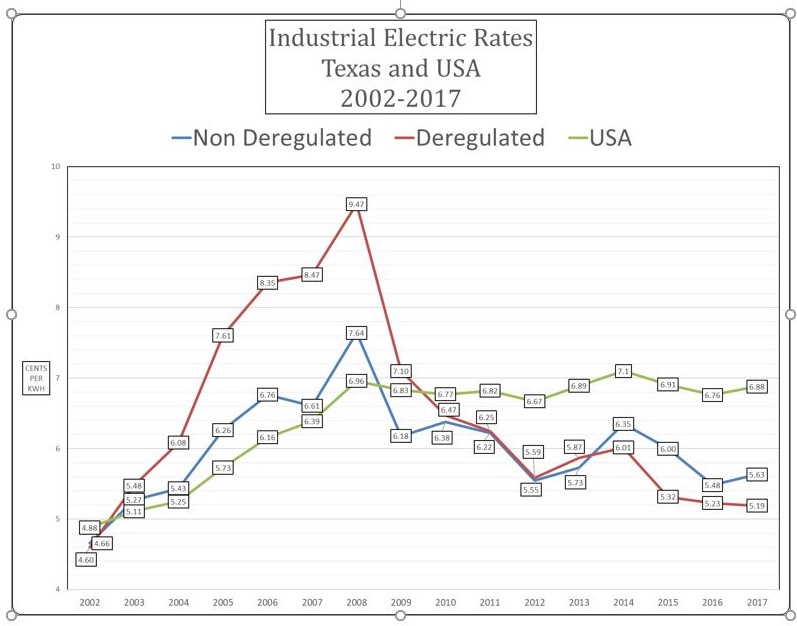Industrial customers generally have fared better under the Texas electric deregulation law than residential customers.
Residential consumers buying electricity from competitive power providers in Texas historically have paid more than those buying power from providers exempt from competition. Our friends at the Texas Coalition for Affordable Power have documented this price disparity over the years and found in its latest report that a small gap remained as recently as 2017.
 In July, TCAP went back through the underlying data, but instead with a focus on commercial customers. This month it examined how large industrial customers have fared.
In July, TCAP went back through the underlying data, but instead with a focus on commercial customers. This month it examined how large industrial customers have fared.
The chart above illustrates average industrial prices for electricity from 2002 through 2017, and includes data points for areas inside deregulated Texas, in areas of Texas outside deregulation and average industrial electric prices nationwide.
As you can see, both deregulated and non-deregulated industrial rates rose to levels above the national average beginning in 2003 and remained above that benchmark for several years. However, deregulated industrial rates increased at a greater pace than non-deregulated industrial rates during that period, and this led to the emergence of a sizable price gap between deregulated and non-deregulated average rates.
This gap hit its peak in the 2007 and 2008. In 2007, Texas industrial customers of deregulated providers paid, on average, 28.2 percent more than customers of non-deregulated providers. In 2008, Texas industrial customers under deregulation paid, on average, 23.9 percent more than those receiving power from non-deregulated providers.
But the trend began shifting the following year with rates in both deregulated and non-deregulated areas falling sharply. By 2010, industrial rates in deregulated areas of Texas dropped below industrial rates nationwide. By 2014, industrial rates in deregulated areas of Texas dropped below the corresponding non-deregulated rates within Texas.
 Under the state’s retail electric deregulation law, consumers living in about 85 percent of Texas have a choice of electric providers. Consumers in the remaining 15 percent of Texas do not have similar options, and instead must purchase electricity from a single deregulation-exempt provider in their area.
Under the state’s retail electric deregulation law, consumers living in about 85 percent of Texas have a choice of electric providers. Consumers in the remaining 15 percent of Texas do not have similar options, and instead must purchase electricity from a single deregulation-exempt provider in their area.
This bifurcated system — with some Texans receiving service in deregulated areas, and others receiving service in areas exempt from deregulation — provides a unique opportunity to compare prices. TCAP conducts its analysis each year and posts its findings on its website.
The TCAP analysis begins in 2002 because that was the first year for retail electric competition in Texas. It ends in 2017 because that is the last year for which data currently exists to conduct analysis. During that year, deregulated industrial rates in Texas were 7.8 percent lower than corresponding Texas rates outside deregulation, according to TCAP.
TCAP retrieved its data for its analysis and for the earlier May Snapshot Report from the United States Energy Information Administration. For more information on how it employs that data and to review the earlier report, go to the TCAP website here.

